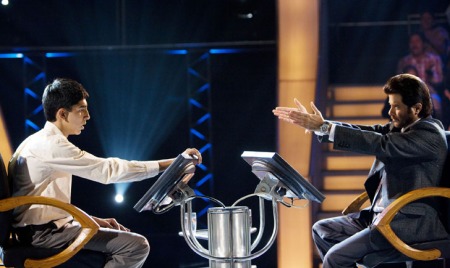Well, it consists of
“nasty below-the-belt potshots at the underbelly of the city, portraying Mumbai as the armpit among the metropolises… it’s crystal clear why this murky and squalid portrait of Mumbai has the Americans preening in delight. At one point after being thrashed mercilessly our hero Jamal tells American tourists, “You wanted to see real India? Here it is. “Now we’ll show you the real America,” the American lady replies, handing Jamal a 100-dollar bill. This, without any apparent sense of irony. This isn’t the ‘real’ India. This is India as seen through the eyes of a Westerner who’s selling desi squalor packaged as savvy slick entertainment. There is a very thin line dividing slick from scum. Slumdog Millionaire doesn’t stop to make those subtle distinctions.”
If this doesn’t bear any resemblance to anything you’ve seen, it’s perhaps worth noting that this comes, only a few days ago, from an Indian film critic, Subhash K. Jha. Most of the Indian film critics I’ve read are generous to Danny Boyle’s film, to a greater or lesser extent, but there are places where the posters have been pulled down, the film denounced, and crowds have congregated to object against it. (There is a separate complaint about the level of payments made to the child actors, but Boyle has rebutted these.)
But I have to say that I loved the film. It’s not often that films are actually applauded at the end, and Slumdog Millionaire deserved every last smack of the hands. I found it hard to think of anything in it that wasn’t brilliantly conceived and executed – even the design and placing of the sub-titles, when needed, was unusual and inventive. And although I haven’t read Vikas Swarup’s novel ‘Q & A’ yet, the film would appear actually to have improved upon the original, in which the Who Wants To Be A Millionare host (Anil Kapoor in a terrific performance) apparently turns out to be contestant Jamal’s father, which would have left a truly saccharin taste in the mouth.

Dev Patel and Anil Kapoor in Slumdog Millionaire
To most punters, this will have been the first film about contemporary India (India is usually seen through skilful adaptations of Raj novels, like Heat And Dust, The Jewel In The Crown, or A Passage To India; or else through the prism of culture-clash ‘issue’ films – set in Britain, for the most part; or else as Bollywood with a twist) they have ever seen. Not only pacy, with the dizzily oblique shots that made Trainspotting so good (and also better than the novel), Slumdog Millionaire takes almost all the Western stereotypes of India you can think of, and both upturns and bends them. We might think: poverty, call centres, trains, Taj Mahal, bright colours, hot spices, and leave it at that. But Boyle’s direction rampages through all these and more. His sensory intelligence is exceptional, showing us the slums of Mumbai as bizarrely beautiful from above and pitiful and mean on closer inspection. It doesn’t wallow in the proximity of wealth and waste, it just lodges it in our brains. It doesn’t dwell on outbreaks of anti-Muslim violence, or on the vicious trade in orphaned beggars – it flashes across both, enough to bother us badly.
Structurally, it’s faultless. The idea, even if borrowed, of using the successive questions and answers in ‘Millionaire’ as the trigger for the flashback life of Jamal, his brother Salim, and his childhood sweetheart Latika, is a terrific framing device, one which lets us into the seedy and the sweet, the violent and the comic, in equal measures. There is swift adventure, expert comedy (the gullibility of heritage tourism), and a series of narrative surprises – not least the moment when the American offers the money, which Subhash K. Jha picks out for scorn. The cheap trick would have been to make the Americans the bad guys. This film has no cheap tricks, except possibly a moment when Jamal appears to be hurling himself and Salim off a half-built tower-block.
There is so much this film does right. The ageing of the children, using three actors apiece, is expert. The flashing shots of obsessive viewers of ‘Millionaire’ as the show works to a climax – these are great (and mirror the obsession that the UK had with the show when it started out). The music is pounding and effusive. And the acting is repeatedly startling – not just the principals, but the minor players: the sign of a great film.
I think that Subhash K. Jha is missing many things about this film, which is one of the best ten I’ve seen this century, and they are summed up in a comment left for an Indian complainant on a web-site. It was from a woman in Edinburgh, who remarked that she liked Trainspotting, and that she liked living in Edinburgh too. This is fiction, intelligent fiction, with some eye-opening, but no preaching. This is no more a picture of Mumbai than Get Carter was of Newcastle, but it gives India its own voice in Western cinema more effectively than any previous film.
Slumdog and the Wrestler were the films of 08 for me. Classy works.
Here’s Amul Butter’s take on this movie. As usual, they find a way to add their butter to the current events.
Sounds like the green-eyed monster at work. I thought the American gave those dollars to assuage her guilt and because she genuinely does care. But this is the limit of what she can do — charity doesn’t change the system but it does make the pain go away for a bit.
Slumdog was an effective tour of what India is like beyond the tourism posters. Both beautiful and distressing, it was a reminder of why we can’t give up the fight against poverty.
It worked as a story, as a movie, as an education, and as an entertainment.